Implementation Enterprise Resource Planning Sales and Purchase of Goods Using WebERP Fushia Clothing Store Denpasar
on
JURNAL ILMIAH MERPATI VOL. 11, NO. 1 APRIL 2023 p-ISSN: 2252-3006
e-ISSN: 2685-2411
Implementation Enterprise Resource Planning Sales and Purchase of Goods Using WebERP Fushia Clothing Store Denpasar
Irianto Yohanes Sampea1, I Putu Agus Eka Pratamaa2, Ni Made Ika Marini Mandenni a3 aDepartment of Information Technology, Faculty of Engineering, Udayana University, Bukit Jimbaran, Bali, Indonesia, phone. (0361) 701806
e-mail: 1iriantosampe16@gmail.com, 2eka.pratama@unud.ac.id, 3made ikamarini@unud.ac.id
Abstrak
Penerapan sistem informasi yang terintegrasi dalam bisnis perlu adanya peningkatan terkait dengan kinerja sistem. Bisnis yang dapat berjalan dengan baik didapatkan jika tiap divisi di dalamnya sudah terintegrasi satu dengan lainnya. Kendala dalam penelitian ini salah satunya proses bisnis penjualan masih dilakukan secara manual, penyimpanan data pada Ms. Excel, dan antara divisi satu dengan divisi lainnya belum terintegrasi. Teknologi yang diajukan sebagai solusi untuk permasalahan ini adalah Enterprise Resource Planning. Penelitian ini dilakukan dengan menerapkan penerapan model ERP menggunakan WebERP, digunakan untuk membantu seluruh rangkaian proses bisnis pada Toko Fushia. Penelitian yang dilakukan berfokus pada tiga bagian proses yaitu pada bagian Sales, Purchase, dan Inventory. Implementasi yang diterapkan telah memenuhi kebutuhan dari Toko Fushia dengan hasil uji coba sistem sebesar 68,82% atau setara dengan skala indeks setuju. Sistem yang diterapkan mampu meningkatkan dan mengintegrasikan seluruh data sehingga proses data menjadi lebih efektif dan efisien untuk digunakan.
Kata kunci: Enterprise Resource Planning, Proses Bisnis, Skala Likert, Toko Fushia, WebERP.
Abstract
Implementation of integrated information systems in business requires improvements related to system performance. Business can run well if each division is integrated with one another. The obstacle in this research is that the sales business process is still done manually, data storage on Ms. Excel, and each division is not yet integrated. The technology proposed as a solution to these problems is Enterprise Resource Planning. The research was carried out by implementing ERP using WebERP which is used to assist the entire series of business processes at Fushia Stores. Research is focused on three parts of the process, namely on the Sales, Purchase, and Inventory. The implementation results have fulfilled the needs of Fushia Stores with a system test result of 68.82% with an agree index scale. The system implemented is able to improve and integrate all data so that data processing becomes more effective and efficient to use.
Keywords: Business Process, Enterprise Resource Planning, Fushia Shop, Likert Scala, WebERP.
Developments to the current era have triggered many businesses competing to improve the quality of ongoing sales in order to maintain business. Information technology is one way that can provide a competitive advantage for a company or business by adding value to various aspects, such as the value chain, operational performance improvement, cost savings, quality improvement and decision making. Adjustments between business processes and information technology must be carried out appropriately so that all available resources can be optimized and information technology becomes an integral part of a company or business. There needs to be an integrated system development approach within the company or business. The current form of approach can be used as well as ERP implementation. The application of Enterprise
Resource Planning (ERP) is a system that is said to be a form of integrating all activities in a business or company, ERP is an integrated computing system that automates information, material flow, and resources into one database [1]. The use of ERP in companies can simplify the entire process of business activities and can also compete with other businesses. The form of one of the strategies used to win or outperform the competition by bringing up competitive advantage, competitiveness is the development of the value that companies are able to create in order to buy it [2]. ERP can be carried out as a form of integration of various existing information systems within the company which can assist in providing various information in real-time regarding the company's business processes such as marketing, production, accounting and finance, resources, purchasing processes, and inventory. [3].
WebERP is a software that can be used to help web-based accounting and business management systems, has various features that are very suitable for use in businesses such as distribution, wholesale, and manufacturing. The available modules are general, security, sales, orders, inventory, and purchasing. WebERP has a significant growth because it is an opensource application so everyone can use this application for free. Completely web -based implementation of PHP (Hypertext Pre-Processor), with the help of MySQL database [4]. Fushia Shop is a business that operates in the field of selling clothes and pants which is located right in the city of Denpasar Bali, where the types of services available are plain t -shirts, shirts and pants. The entire series of business processes contained therein still use manual methods or processes. The entire data that is recapitulated is only stored in a manual data system, namely Ms. Excel and is still entered one by one for each existing data and there is no integration of information between one division and another. ERP implementation is carried out using the WebERP system at the Fushia Denpasar Store. WebERP implementation is carried out using the help of web-shaped software that can be accessed easily with the help of the internet. This study applies an ERP system focusing on sales and purchase business processes.
The research method is the stage of each process flow that will be carried out in research. The stages of the research process that will be used in this study have eight stages of the process, literature study, data collection, business process analysis, new business process proposal, WebERP implementation, business process implementation, test results and conclusions. An overview of the research flow can be seen in Figure 1.
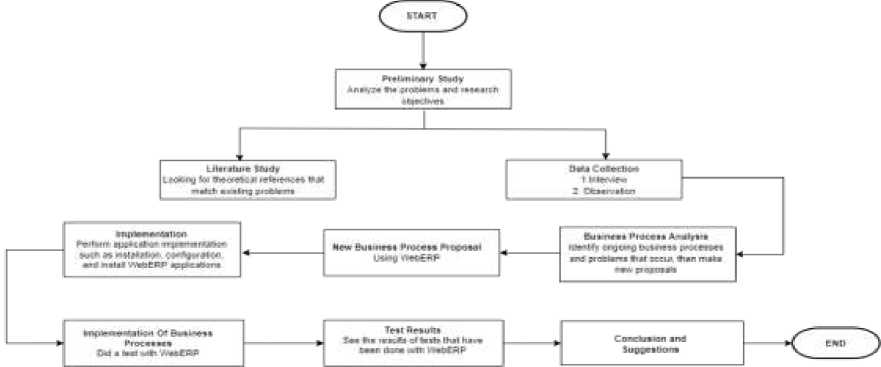
Figure 1. Research Methods
Figure 1 above is the stages of the research process used in ERP implementation at Fushia Stores using WebERP software. The stages used in this study are divided into eight stages namely stages of the process, literature study, data collection, business process analysis, new business process proposal, WebERP implementation, business process implementation, test results and conclusions.
The literature study was carried out by collecting several theories, methods or models related to the research to be carried out or regarding the concept of the ERP module and WebERP. Literature studies are obtained from various sources including books, journals, or scientific papers so as to strengthen the theoretical basis used in research which also provides a basis and reference for research direction.
Data collection is a collection of facts, figures, objects, symbols and events collected from various sources. Where data collection is made to make better decisions. Without data, it will be difficult to make the right decision, so it is necessary to collect data. Data collection was carried out in two ways, namely interviews and direct observations at the Fushia Clothing Store research site, carried out by direct discussions with business owners and direct observations in the sales, purchasing and inventory
Business Process Analysis is a needs analysis for users of the WebERP system in the Fushia store to make decisions about the WebERP module to be implemented. Other activities carried out at this stage are trying to find differences between the company's business processes and those in the WebERP system and designing business flows to support and find the most effective and efficient business processes for Fushia stores. New Business Process Proposal Process submitted by researchers related to new business processes that will be developed into more effective and efficient business processes. Proposed new business processes using enterprise resource planning applications using WebERP software.
The stages are carried out by implementing the proposed new business process. The results of execution or implementation on the WebERP system after designing the most efficient company business processes using the BPR (Business Process Reengineering) method[5]. This stage is carried out by transferring data and information from the previous system to the latest ERP system. Testing using UAT (user acceptance testing) directly on the Fushia Shop business.
The results were carried out by testing the UAT directly on the Fushia Store business in the sales, purchases and inventory sections. The tests carried out will be processed by looking at the ratings given by each user in order to determine the success rate of the WebERP software used.
Literature studies related to common problems for developing knowledge in order to adapt the WebERP system were obtained from previous research articles, books and journals.
Enterprise Resource Planning (ERP) is a form of information system that has been integrated and can connect many types of needs in information systems as a whole and specifically for the various needs of different departments within a company or business[6]. ERP itself consists of various modules that are suitable for various kinds of needs within a company, the use of ERP itself has made the existing information system within a company become a system that integrates with each other from one field to another, so that all departments will be easier to manage. share data using one database [3] [7].
WebERP is a management and accounting system in business with a web base that has many features that are suitable for use, especially in the fields of distribution, manufacturing and wholesale. WebERP has several modules including security, sales, general, orders, taxes, inventory, purchasing, accounts payable, banking, manufacturing, contract coting, and fixed assets. WebERP has a very significant growth because the opensource application can be accessed by everyone for free, and fully uses the PHP-based programming language (PHP Hypertext Pre-Processor) using the MySQL database [4].
Business process reengineering (BPR) is a competency that can change business processes as a whole with the aim that business processes can become more active and efficient without any changes to the organizational structure and function of the business process itself [10]. The business management approach focuses on the analysis and design of workflows and business processes within an organization. With the aim that BPR can help organizations rethink business processes in improving business performance [9] [11].
User Acceptance Testing (UAT) is a form of testing process by users that is intended to produce documents that are used as evidence that the software that has been created and developed has been acceptable to users. Tests that are carried out at the end or final of the software and are carried out before it is developed [12] [13]. The Likert scale is a form of psychometric scale that can generally be used as a reference for a questionnaire and is the most widely used scale in research in the form of survey results. This scale is named after the inventor Rensis Likert, who published a report describing its users. Users can determine their level of assessment of the questions given by selecting one of the available options [14] [15].
The results and discussion contain related implementation of Enterprise Resource Planning using WebERP software, contains related business process flows that are currently running and proposed business process flows and the results of system testing.
Business processes that are currently running at the Fushia Store, starting from the sales process to purchasing goods.

Figure 2. Existing Business Process
-
Figure 2 is a business process that is currently running in the Fushia Store business today. The SOP above describes the stages of the business process starting from product
sales, goods inspection, goods purchases, to the production department. Where the sales department is responsible for compiling sales orders, creating invoices, verifying payments, and creating sales notes. The inventory section operates the purchase and receipt of raw materials, checks the availability of goods, and sends the goods produced in accordance with the results of customer orders. The manufacturing department operates the production process based on customer orders.
Business process reengineering is done by adding 2 processes to complement the existing processes. The added processes, namely purchase and accounting, are adjusted to the WebERP software business processes.
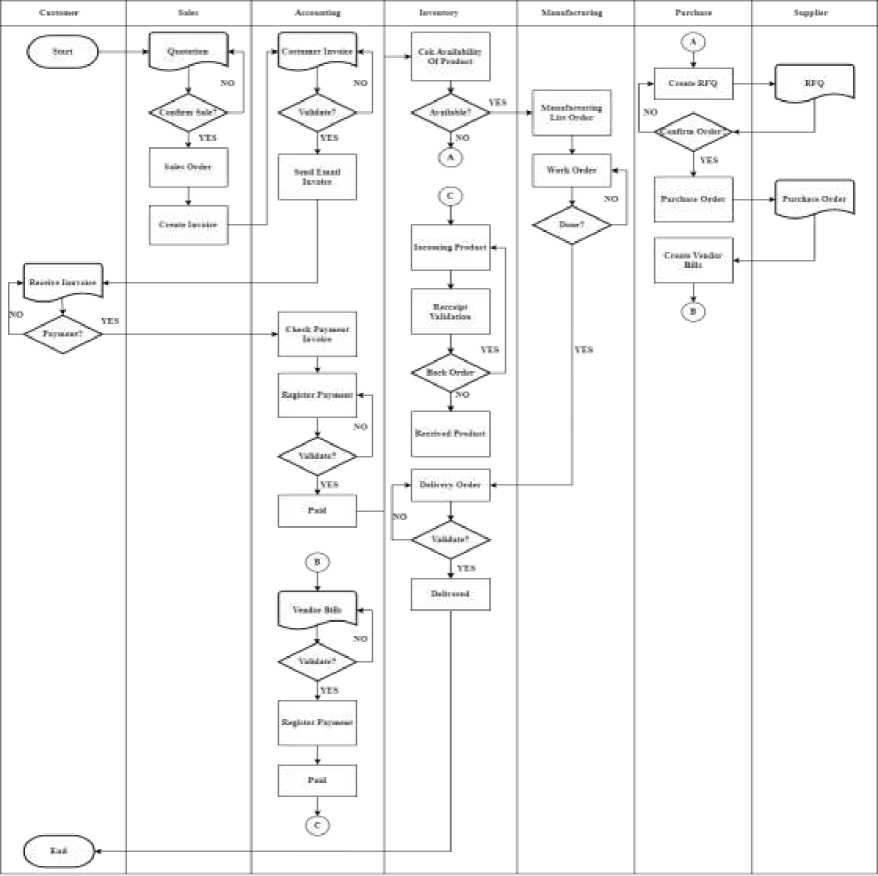
Figure 3. Proposed Business Process
-
Figure 3 is a proposed business process using BPR, the proposed business process as a whole has links between each process, there are 3 main processes, namely the sales process, the purchasing process and the inventory process.
Implementation of new business processes with WebERP software at Fushia Stores.
Implementing 2 main processes, namely the sale and purchase of goods.
The sales process is a transaction activity between sales and buyers. The process of selling goods is as follows.
Customer data serves to provide information related to customer data that will make a purchase. The purpose of having customer data is so that the company can find out the purchase transactions that have been made. Relevant customer data can be filled in the form of customer name, telephone number, email address and other data information.
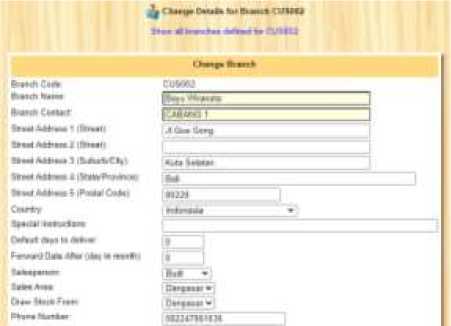
Figure 4. Customer Data
-
Figure 4 above is the display result of customer data that has been entered into the WebERP system, where the data entered is in the form of the customer's name, address, telephone number and other complete data.
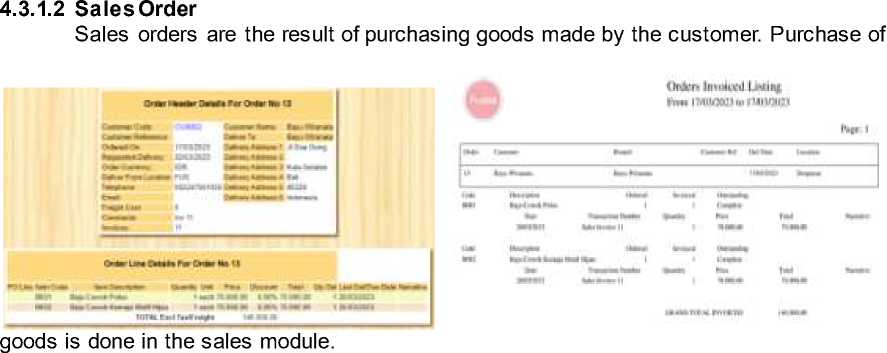
Figure 5. Sales Order
-
Figure 5 above is a display of a sales order. Customer orders that have previously been made and confirmed according to the order, customer order details will be generated automatically. The order display that will appear is in the form of customer order details in the form of delivery destinations and includes the items purchased. The transaction display is in the form of a purchase invoice that will be given to the customer as proof of a payment transaction that must be made.
The purchasing process is a transaction activity between the company and the supplier. The process of purchasing goods is done by buying goods that are already in the supplier. The process of purchasing goods is as follows.
Supplier data serves to provide relevant information related to supplier data that will supply goods to the company. The purpose of having supplier data is so that the company can find out the purchase transactions of goods from suppliers. Related supplier data can be filled in the form of supplier name, supplier code address, email address, number, and other data information.
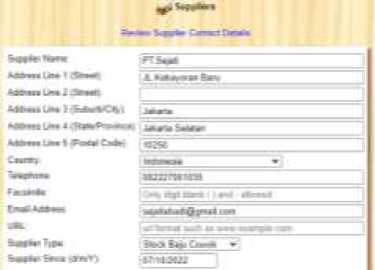
Figure 6. Supplier Data
Figure 6 above is the display result of supplier data that has been entered into the WebERP system, where the input data is in the form of supplier name (PT), address, telephone number, type of supply goods and other complete data
Purchase order is the process of purchasing goods from the company to the supplier. Purchase orders for goods are created in the purchase module.
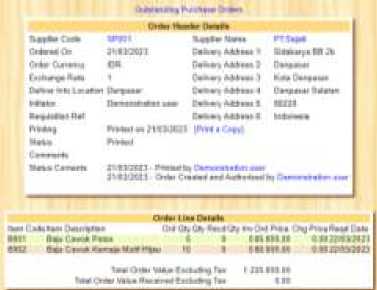
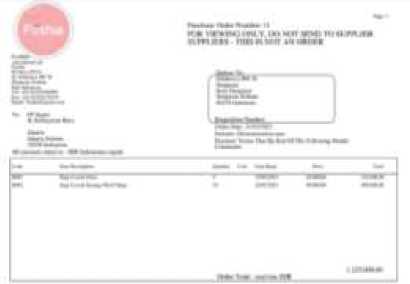
Figure 7. Purchase Orders
Figure 7 above is a display of a purchase order. Ordering goods according to the input data of goods is done directly by Fushia Store. The results of ordering the appropriate goods will be confirmed again in the inventory section to re-check the order. The appropriate order will automatically display detailed data on the order of goods in the form of the delivery destination and list the items ordered to the supplier. Vendor Bills are proof of invoice for the purchase of goods that must be paid by the customer in accordance with the number of purchases made. The payment process is carried out when the order arrives at the store. The store will send order details in the form of an invoice purchase order file to the supplier as proof of each order required by the store.

Figure 8. Goods Confirmation Details
Figure 8 above is a display of detailed confirmation of goods received from suppliers. Goods that have been received by the store will be checked again according to the invoice ordered, when appropriate, it will proceed with approving the "received" order. The results on ordering goods will automatically change the status from initially "printed" to "complete" goods received.
Inventory of goods is a process related to the availability of goods in the store. The inventory process can be done in the inventory module.
Availability of goods is a place used as storage of goods. Availability of goods can be seen in the inventory module
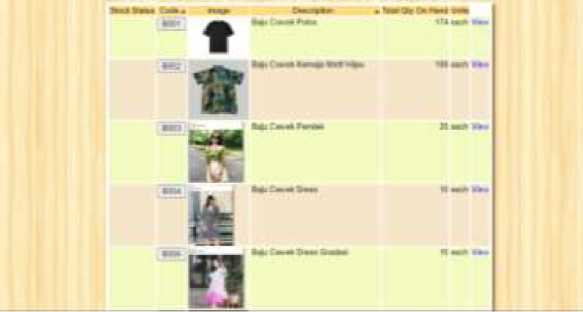
Figure 9. Items Available
Figure 9 above is a display of the inventory module. The inventory view displays the items in the store (in stock) complete with item details starting from the item code, item name, image, and item stock. Inventory display can make it easier for stores to always check the availability of existing items. It can be seen that there are several items available, such as men's plain shirts, men's green patterned shirts, women's short shirts, women's dress shirts, women's gradation dresses and several other items available at the store.
The results of system testing were carried out at the Fushia Store by involving all existing workers with a total of 6 workers and 4 students. The test was carried out by the owner as the shop owner, there were 2 people from sales, 1 person in accounting, 2 people in inventory and 4 students. Measurement testing is done by giving questionnaires directly to the user. The questionnaire consists of 12 questions consisting of 7 questions on the functionality aspect and 5 questions on the user interface (UI) aspect. Testing was carried out using the UAT (User Acceptance Testing) method and the Linkert scale. Assessment points consist of 5 choices, namely Strongly Disagree, Disagree, Enough, Agree and Strongly Agree. Calculation
of the maximum score is done to determine the index score (%) later. The maximum score is obtained by multiplying the number of respondents with the highest Likert score [15].
Respondent Score Presentation Score % =---------------x 100
Maximum Score
P-x100 N
To determine the index value (%). Calculations can be made by adding all the results of the scale values, then dividing by the maximum score, then multiplying by 100. The index value (%) obtained will be put into several categories as follows.
Table 1. Category Index
|
Index (%) |
Skala/Value |
|
0%-20% 21%-40% 41%-60% 61%-80% 81%-100% |
Very Not Agree Disagree Enough Agreed Strongly Agree |
Table 1 is the result of the category index (%). The index value range is divided into 5 parts according to the Likert scale determination starting with 0(%)-20(%) very not disagree, 21(%)-40(%) disagree, 41(%)-60(%) enough, 61(%)-80(%) agreed, and 81(%)-100(%) strongly agreed [15].
|
Table 2. Results of Respondents' Answers on Functional Aspects | ||||||
|
No |
Question |
Scoring scale | ||||
|
STS KS |
C |
S |
ST |
Total | ||
|
Respondents | ||||||
|
1. |
WebERP software is easy to learn. |
5 |
3 |
2 |
10 | |
|
2. |
WebERP software is easy to access. |
7 |
3 |
10 | ||
|
3. |
WebERP software has fulfilled the business processes carried out. |
1 |
5 |
3 |
1 |
10 |
|
4. |
WebERP software is useful for product data collection. |
2 |
5 |
3 |
10 | |
|
5. |
WebERP software simplifies the work process. |
4 |
3 |
3 |
10 | |
|
6. |
WebERP software is more efficient and effective. |
6 |
4 |
10 | ||
|
7. |
WebERP software is able to provide information according to the needs of each division. |
6 |
3 |
1 |
10 | |
Table 2 above is the result of a summary of the functional aspects that have been grouped based on the respondents' answers. There are 7 questions that will be given responses by respondents according to the existing aspects of the assessment. Respondents totaled 10 people consisting of the owner, 2 people from sales, 1 person from accounting, 2 people from inventory, and 4 students.
|
Table 3. Results of Respondents' Answers on User |
Interface (UI) Aspects | ||||
|
No |
Question |
STS KS |
Scoring scale C S ST Total Respondents | ||
|
8. |
WebERP software is easy to use. |
2 |
6 |
2 |
10 |
|
9. |
Display design in terms of graphics is quite efficient and attractive. |
2 |
6 |
1 |
1 10 |
|
10. |
User size letters or writing that are easy to see and understand. |
1 |
7 |
2 |
10 | |
|
11. |
Attractive display color users. |
1 |
3 |
3 |
3 |
10 |
|
12. |
Navigation is quite easy to do. |
1 |
8 |
1 |
10 | |
Table 3 above is the result of a summary of the user interface (UI) aspects that have been grouped based on the respondents' answers. There are 5 questions that will be given responses by respondents according to the existing aspects of the assessment. Respondents totaled 10 people consisting of the owner, 2 people from sales, 1 person from accounting, 2 people from inventory and 4 students. The average questionnaire results are described in table 4.
Table 4. UAT Calculation Results
|
No |
Value f |
Value P (%) |
Category |
|
P1 |
27 |
54,00% |
Enough |
|
P2 |
43 |
86,00% |
Strongly Agree |
|
P3 |
34 |
68,00% |
Aggreed |
|
P4 |
41 |
82,00% |
Strongly Agree |
|
P5 |
39 |
78,00% |
Aggreed |
|
P6 |
34 |
68,00% |
Aggreed |
|
P7 |
35 |
70,00% |
Aggreed |
|
P8 |
30 |
60,00% |
Enough |
|
P9 |
31 |
62,00% |
Aggreed |
|
P10 |
31 |
62,00% |
Aggreed |
|
P11 |
38 |
76,00% |
Aggreed |
|
P12 |
30 |
60,00% |
Enough |
|
Rata-rata |
34,41 |
68,82% |
Agreed |
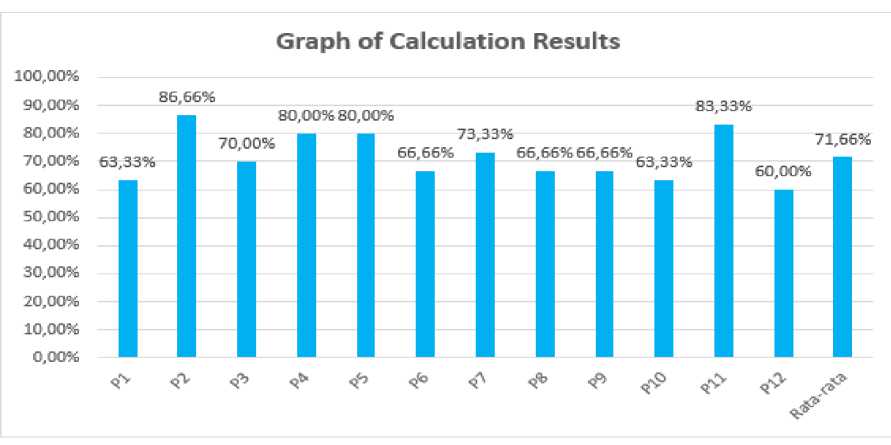
Table 4 above is the final result of the calculation (User Acceptance Test), where the presentation results obtained are 68.82% which are included in the index category (Agree) that the implemented system has met the store's needs.
Based on the results of research that has been done by implementing Enterprise Resource Planning at Fushia Stores, it can help manage business processes that previously used conventional processes. Implementation is carried out using open source WebERP-based software that focuses on the implementation of sales and purchase of goods. Based on the
results of the calculation analysis using the UAT WebERP method, it can help existing business processes become more effective and efficient. It just takes more time for shops to learn each module to take full advantage of WebERP.
References
-
[1] P. P. Wrestra Saridewi, I. K. G. D. Putra, and I. M. Sukarsa, “Implementation of Enterprise Resource Planning at CV. Dewi Bulan,” J. Ilm. Merpati (Menara Penelit. Akad. Teknol. Informasi), vol. 9, no. 3, p. 226, 2021, doi: 10.24843/jim.2021.v09.i03.p04.
-
[2] R. Mohamad and I. Y. Niode, “Analisis Strategi Daya Saing (Competitive Advantage) Kopia Karanji Gorontalo,” Oikos Nomos J. Kaji. Ekon. dan Bisnis, vol. 13, no. 1, pp. 1– 14, 2020, doi: 10.37479/jkeb.v13i1.7062.
-
[3] M. W. Butar Butar, G. M. A. Sasmita, and D. P. Githa, “Implementasi Enterprise Resource Planning untuk Toko Bangunan Studi Kasus UD. Mandala Jaya,” J. Ilm. Teknol. dan Komput., vol. 2, no. 2, pp. 383–396, 2021.
-
[4] R. G. Hidayat, I. Nuryasin, and W. Suharso, “Implementasi Sistem Informasi Penjualan dan Persediaan Menggunakan webERP Pada Cribo Inc Malang,” J. Repos., vol. 2, no. 8, pp. 1067–1074, 2020, doi: 10.22219/repositor.v2i8.906.
-
[5] M. Arip and W. Hadikurniawati, “Implementasi Metode Business Process Reengineering ( BPR ) Pada Sistem Pelayanan Data Penduduk,” no. 1, 2022.
-
[6] A. Putra, E. Wibowo, and A. H. Ismanto, “Implementasi Enterprise Resource Planning (Erp) Pada Menggunakan Dolibarr (Studi Kasus : Pt Karya Tani Indonesia),” Nusant. J. Community Engagem. E, vol. 2, no. 1, pp. 2722–2411, 2021, [Online]. Available: http://ejournal.kopertais4.or.id/tapalkuda/index.php/NJCE/index
-
[7] I. P. A. E. Pratama and I. W. Robiulla, “Penerapan Modul Pembelian Pada Industri
Manufaktur Interior Rumah Dengan Menggunakan Erpnext,” J. Resist. (Rekayasa Sist. Komputer), vol. 2, no. 1, pp. 41–47, 2019, doi: 10.31598/jurnalresistor.v2i1.350.
-
[8] R. H. Wahyuni, I. M. Sukarsa, and D. M. S. Arsa, “Reengineering Business Process Manufacturing Company Sales Module Using Odoo V12.0 Application,” J. Ilm. Merpati (Menara Penelit. Akad. Teknol. Informasi), vol. 9, no. 3, p. 188, 2021, doi: 10.24843/jim.2021.v09.i03.p01.
-
[9] L. Setiyani, G. T. Liswadi, and A. Maulana, “Proses Pengembangan Proses Bisnis Transaksi Penjualan pada Toko Erni Karawang bisnis yang mendukung kegiatan bisnis yang memperkuat dan meningkatkan manajemen bisnis , maka konsep yang di pakai adalah bisnis usaha maka pelaku dari sebuah sudah melekat di ,” vol. 16, pp. 39–45, 2022.
-
[10] R. Fajriah and S. Nazar, “Analisa Business Process Reengineering Dalam
Pengembangan Sistem Distribusi Produk Lensa Mata Berbasis Mobile Application,” CESS (Journal Comput. Eng. Syst. Sci., vol. 5, no. 1, p. 1, 2020, doi: 10.24114/cess.v5i1.14353.
-
[11] R. Bimantara, I. Putu, A. Bayupati, and N. K. Rusjayanthi, “Business Process Reengineering and ERP System Im-plementation in Design Company,” JITTER-Jurnal Ilm. Teknol. dan Komput., vol. 3, no. 1, 2022.
-
[12] M. A. Chamida, A. Susanto, and A. Latubessy, “Analisa User Acceptance Testing
Terhadap Sistem Informasi Pengelolaan Bedah Rumah Di Dinas Perumahan Rakyat Dan Kawasan Permukiman Kabupaten Jepara,” Indones. J. Technol. Informatics Sci., vol. 3, no. 1, pp. 36–41, 2021, doi: 10.24176/ijtis.v3i1.7531.
-
[13] S. Aziza and G. H. N. N. Rahayu, “Implementasi Sistem Enterprise Resource Planning
Berbasis Odoo Modul Sales Dengan Metode Rad Pada Pt Xyz,” J. Ind. Serv., vol. 5, no. 1, pp. 49–58, 2019, doi: 10.36055/jiss.v5i1.6503.
-
[14] A. H. Suasapha, “Skala Likert Untuk Penelitian Pariwisata; Beberapa Catatan Untuk
Menyusunnya Dengan Baik,” J. Kepariwisataan, vol. 19, no. 1, pp. 26–37, 2020, doi: 10.52352/jpar.v19i1.407.
-
[15] U. Rahardja, N. Lutfiani, and R. Rahmawati, “Persepsi Mahasiswa Terhadap Berita Pada
Website APTISI,” Sisfotenika, vol. 8, no. 2, p. 117, 2018, doi: 10.30700/jst.v8i2.400.
Implementation Enterprise Resource Planning Sales and Purchase of Goods Using WebERP 49
Fushia Clothing Store Denpasar (Irianto Yohanes Sampe)
Discussion and feedback